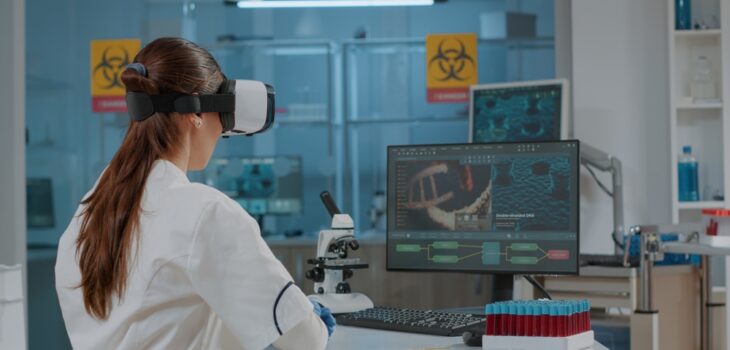 Education
Education
Beyond Conventional Tools Harnessing Virtual Reality for Scientific Research
- by Arina Wilson
Imagine donning a VR headset, and instead of preparing for battle or engaging in car races, you find yourself immersed in a neuron-dense landscape within the human brain. Here, you navigate complex pathways, unraveling the mysteries of cognition.
Moreover, envision a classroom where students, regardless of their locations, jointly explore ancient ruins, dissect virtual frogs, or stroll through the double helix of DNA.
The digital transformation isn’t limited to education; cognitive scientists now employ VR headsets as tools akin to scalpels. They dissect the intricate fabric of human consciousness and push the boundaries of perception and memory.
Psychologists leverage these digital realms to gently expose patients to their deepest fears, creating safe environments that feel as real as the outside world, fostering healing and mental resilience.
Virtual Reality (VR) stands as a recent technological marvel, presenting endless opportunities for researchers, entrepreneurs, and VR for higher education.
Nowadays, scientists are actively exploring and advancing this technology, experimenting with diverse applications. Plus, curated as a commercial triumph with major investments from companies like Google, Microsoft, and Samsung for recreational use, VR for scientific research holds substantial potential. Its applications extend to education, medical treatments, research, neuroscience, and intricate data management, ushering in a new era of possibilities.
VR and Scientific Research Goes Hand in Hand
The term VR was coined by American scientist Ivan Sutherland, who defined it as a window through which users can perceive the virtual world as if it were real (Cipresso et al., 2018). Since its conceptualization in 1965 in Sutherland’s article “The Ultimate Display,” VR has undergone significant advancements.
However, its appeal isn’t solely rooted in offering a new perspective on the virtual world; indeed, its allure lies in the research opportunities it brings.
Researchers are drawn to VR because it enables the substitution of the physical landscape with a virtual one, offering greater control over experiments and a risk-free environment. Importantly, VR allows the creation of a simulated environment that users can interact with from the safety of their computers.
Moreover, our minds perceive the digital simulation similarly to a real-life situation when immersed in the virtual world.
This feature allows the monitoring of how the mind and body respond to various stimuli. It’s crucial to note that there is a subtle difference between VR and Augmented Reality (AR). AR involves overlaying virtual elements onto existing, real-life images, as exemplified by Ikea’s app, which projects virtual furniture into a photo of your room, whereas VR is creating a whole virtual environment.
Current Research With Virtual Reality
VR has made substantial contributions to modern science, particularly in the realm of medical research. These contributions can be categorized into three key areas: testing specific human brain capabilities, creating virtual labs for the treatment of mental and physical conditions, and enhancing medical education through simulations.
In the context of VR for scientific research, VR simulations have played a significant role, especially in medical training. Medical professionals are using this technology to practice various procedures without the need for real patients or live tissue. Beyond educational applications, VR has also facilitated breakthroughs in neuroscience.
Earlier, scientists relied on rodents or other mammals to understand human brain function and perception due to limitations in testing human subjects in specially designed mazes. However, with virtual science labs, the Virtual Maze Neuroscience Application enables the observation of human brain responses, allowing neuroscientists to study social interactions and spatial intelligence.
VR’s utility extends to creating detailed 3D representations of complex datasets. For instance, a virtual projection of the brain was generated based on extensive scans, providing scientists with an opportunity to examine the organ in intricate detail. Looking ahead, researchers envision creating simulations of gene expression patterns and brain activity to gain deeper insights into physiological processes as they occur in real life.
Conclusion
Though VR is commonly associated with recreational use and science fiction, its applications extend beyond these realms. The VR technology holds the potential to revolutionize various research practices and has tangible applications that aid individuals with medical issues.
The extent to which VR for scientific research transforms scientific endeavors relies on researchers’ ingenuity and their ability to adapt the technology to their specific requirements. Researchers need not worry about their lack of expertise in VR, as many companies are dedicated to assisting them in developing VR experiments.
Researchers can enlist the help of professionals to program and model experiments, as well as obtain customized equipment tailored to their needs and budget. This illustrates the considerable advancement of technology and the myriad opportunities it presents for scientists.









